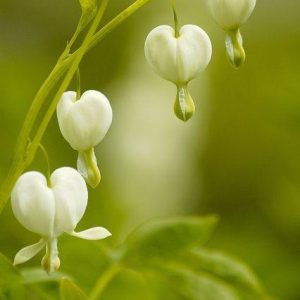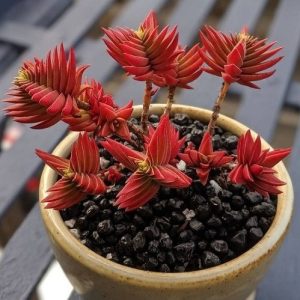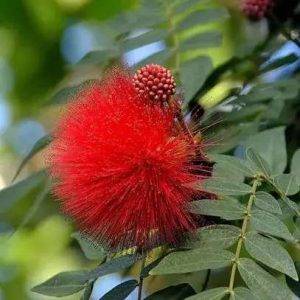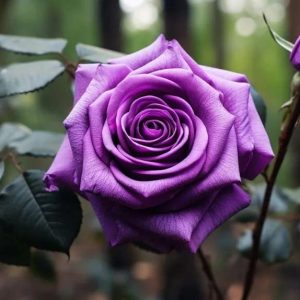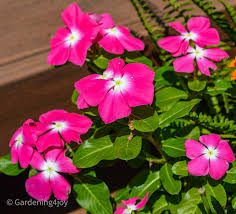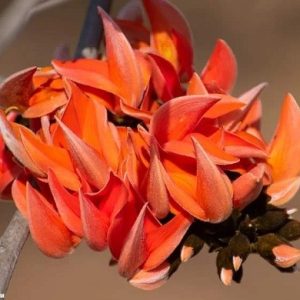I am a cold climate gardener. I consider myself a zone 3 gardener, although my region has recently been upgraded to zone 4. We have winter for 5-6 months of the year it seems. But, even with the harsh long winters, and the short sweet growing season, I am able to grow lush green gardens. One of the biggest challenges is picking the right plant for the right spot. Make sure before purchasing a perennial, that you’ve looked at what conditions (sun, soil, water) it needs and if you are able to provide it with those conditions in your garden.
Also, when choosing perennial flowers, look closely at the bloom times. Try and stagger them out to enjoy something blooming all year. If you only have plants that bloom in the spring, you will have plain green beds for the rest of the summer. In this guide, I’ve included some general bloom times to help you create a good flow of flowers throughout the season.
In the article below, I walk through my favorite perennial plants for zone 4 gardens. I’ve included plants for a variety of growing conditions. I also tried to pick some more unique plants that you may not have considered. If you aren’t in zone 4, but zone 3, zone 5, 6, or 7, this is a great guide for you too as there is plenty of overlap. Let’s jump in!

- Plant Type: Perennial
- Geographic Origin: Eastern Asia
- Sun Exposure: Partial to Full Shade
- Zone: 3-9
- Plant Size: 12″+ high, 4′ wide
- Bloom Time: Spring
If you want to attract attention in your zone 4 garden then tell everyone you are growing kiwis!
It is entirely possible! These hardy kiwis are a lovely vine and they actually produce tiny, tart, kiwis. The leaves on a kiwi vine are mostly green, with some variegated patches of white and blushing red. They have small white blossoms in the spring which is what will turn into the kiwi fruits.
In order to produce fruit make sure you have both a male and female vine (they will be labeled at the store) or consider purchasing ‘Issai’ which does not require both a male and female in order to produce fruit. The fruits are small oblong berries. On the inside, they are little green kiwi fruit.
Kiwi vine is a shady vine, it prefers partial shade. Keep it in evenly moist soil with lots of organic matter. This vine does not need to be cut down every year, it grows on old wood.

- Plant Type: Perennial
- Geographic Origin: Eastern North America
- Sun Exposure: Full Sun to Partial Shade
- Zone: 3-9
- Plant Size: 6″ high, 18″ wide
- Bloom Time: Summer
There are many varieties of cranesbill geraniums. They can get weedy and spread. That is why I want to focus on a specific variety that I love. Ballerina cranesbill geranium is a nice small mound and it has intricate pink and white flowers.
It has the same lacy foliage as other cranesbill geraniums. However, it stays a small size and has really intricate and lovely flowers that will bloom throughout the season.
Ballerina cranesbill geraniums like sun to part shade conditions. They don’t care too much about soil quality, sandy soil is fine. Water them to establish, and then they don’t require any extra water.

- Plant Type: Perennial
- Geographic Origin: East Asia
- Sun Exposure: Full Sun to Partial Shade
- Zone: 3-8
- Plant Size: 18″ high, 18″ wide
- Bloom Time: Summer
The balloon plant is a great late summer blooming perennial. What makes it so special is how it is a little parcel that turns purple and then explodes into a big purple flower. This is a lovely small perennial flower that should be placed in front of a bed or near a feature like a birdbath or a statue so people can come along and admire it up close.
I also love when the dew hits it and little droplets settle into its leaves before it has a chance to bloom in the late summer.
Ballon flowers like full sun to part shade. They like nice moist free-draining soil amended with lots of organic matter.

- Plant Type: Perennial
- Geographic Origin: North America
- Sun Exposure: Full Sun to Part Shade
- Zone: 3-9
- Size: 3′ high, 4′ wide
- Bloom Time: Summer
Bee balm is a perennial that is in the mint family. So it has the wonderful smell of bergamot that is associated with Earl Gray Tea. It is a nice tall perennial that blooms shaggy flowers that are commonly red but also come in pink, purple, and white.
They have a shaggy collar and then a pouf of flower petals out the top. They remind me of a muppet character. These flowers attract pollinators like crazy. And they last a long time in the garden. They are also deer resistant, and can grow in a variety of soil conditions, including soil that’s lower quality.
My favorite variety of bee balm is ‘Bubblegum Blast’. This is a dwarf variety that only reaches 2 feet tall. It boasts a very full and dense clump of bright bubblegum pink flowers.
Bee balm is known as a full sun plant, but it does well in a part shade garden as well. Bee balm likes the classic rich loose free-draining soil that a lot of perennials prefer. They also prefer evenly moist soil. So plant this one in a garden bed alongside other perennials that love those conditions.

- Plant Type: Perennial
- Geographic Origin: North America
- Sun Exposure: Full Sun
- Zone: 4-9
- Plant Size: 3′ high, 2′ wide
- Bloom Time: Fall
Black-eyed Susans are one of my favorite perennials because it fills a gap in bloom times. I find after all the spring and early summer bloomers have done their thing, there is a bit of a lag in blooms. But rudbeckias fill that gap. It starts to bloom in early fall and it looks big and bright and screams fall flowers with its classic sunflower coloring.
I don’t cut these flowers down in the fall, I leave them up through the winter because they look great glistening with frost and sparkling snow. Then I clip them back in the spring and they grow all over again.
Rudbeckia like full sun and evenly moist fertile soil. I like to just plant a few of these here and there in a garden and they look like unassuming leafy greens until late fall comes and they become a focal point.

- Plant Type: Perennial
- Geographic Origin: Eastern North America
- Sun Exposure: Full Sun
- Zone: 3-8
- Plant Size: 2′ high, 18″ wide
- Bloom Time: Late summer
Blazing Stars is another great perennial that fills the gap between summer and fall-blooming plants. It blooms in the late summer and stays in bloom for a long time. It has feathery spikes of purple flowers on a long, narrow-leafed plant. It adds great texture to the garden along with a pop of bright purple color.
Blazing stars look great in a perennial border, maybe mixed in with another earlier blooming plant, like a salvia or day lily. They attract bees like crazy and are wonderful in a pollinator garden. Blazing stars are also native to North America, making them a great option for gardeners that prefer native wildflowers.
Plant blazing stars in full sun. It doesn’t care too much about soil conditions. It will only need extra water to establish, and then it is a great water-wise plant in the garden.

- Plant Type: Perennial
- Geographic Origin: Asia Minor
- Sun Exposure: Full Sun
- Zone: 3-9
- Plant Size: 6″ high, Spreading
- Bloom Time: Spring
Blue wooly speedwell (or Tidal Pool Veronica as I’ve always known it), is another great choice for an evergreen perennial ground cover. It has fine wooly foliage that blossoms into small flowers that are a perfect crystal blue color. Blue is a rare color for a flower, so people are bound to take notice of it in early spring.
I really like when a plant doesn’t require much fall and spring care. This one (as well as creeping phlox), does not need to be cut down in the fall. In the spring I will trim any dead parts out and give it a good scruff to let the new green growth come through.
Use blue wooly speedwell as a border ground cover. Or in a rock garden spilling out over the rocks and trailing down between the crevices. This plant likes poor rocky soil, full sun, and doesn’t require much water after it is initially established.

- Plant Type: Perennial
- Geographic Origin: Europe and Western Asia
- Sun Exposure: Full to Partial Sun
- Zone: 3-8
- Plant Size: 3′ high, 3′ wide
- Bloom Time: Summer
This flower I think gets a bad rap because of its relation to the weed, creeping bellflower. Before you cringe and look for the next option, clustered bell flower is not the same. Creeping bellflower, or zombie weed as it is sometimes called, is in the same family as clustered bell flowers, but trust me, they are not the same. If you haven’t had the displeasure of dealing with creeping bellflower, it is an invasive weed that spreads like crazy, and never dies!
Ok, now that that unpleasantness is out of the way, let’s talk about the lovely clustered bellflower. This one is still very prolific, it grows fast and spreads. But it has these lovely clusters of vivid purple bell-shaped flowers. If you are looking to fill a space, this will do it, and it is lovely and elegant.
These prefer sun conditions but will take part shade. They don’t care about soil or water. They are easy, low-maintenance, spreading perennials.

- Plant Type: Perennial
- Geographic Origin: East and Central North America
- Sun Exposure: Partial to Full Shade
- Zone: 4-9
- Plant Size: 12″ high, 12-24″ wide
- Bloom Time: Summer
I didn’t include hostas in this list because they are an obvious choice for any zone 4 shade garden. But if you are looking for a leafy marvel to add to your garden, or if you want to break up a shady hosta garden with a bit of different foliage texture and color. Coral bells are a great choice.
There are many different types of coral bells. They come in deep purples, bright green, red, frosted purple, and more. I love adding them to foliage beds that need an extra boost of color. This creates a patchwork of colors and textures. Coral bells do flower in the summer. They have sprays of delicate pink or white flowers.
Heuchera thrives in shade or part shade conditions. They like evenly moist soil filled with rich organic matter. This is actually perfect, since other shade companions such as hostas, hydrangeas, and ferns (and more) like the same growing conditions.

- Plant Type: Herbaceous Perennial
- Geographic Origin: North America
- Sun Exposure: Full Sun
- Zone: 3-9
- Plant Size: 3″ high, Spreading
- Bloom Time: Spring
Creeping phlox is a gorgeous evergreen hardy ground cover. It has fine, moss-like foliage (it is also known as moss phlox) that sticks around year-round. But in the early spring, it is a carpet of star-shaped flowers.
They come in white, pink, and purple. My favorite is ‘Candy Stripe’, which has a light pink color with a white margin. It is such a cheery sight in the spring.
Plant creeping phlox in full sun. It doesn’t care much about the soil conditions, rocks and sand are just fine. Once it is established, it is drought tolerant. I really like using this dainty flower in some of the toughest areas of the garden, like in rock gardens, or along driveways. I mass plant it to create a river of phlox down the edge of a garden.

- Plant Type: Herbaceous Perennial
- Geographic Origin: Southeast Europe, Turkey, and Libya
- Sun Exposure: Full to Part Sun
- Zone: 3-8
- Plant Size: 12″ high, 24″ wide
- Bloom Time: Spring
I love this cheery spring flower. In the early spring, it pops out and has bright yellow flowers. The flowers look like they’ve been spray-painted on the leaves. The plant forms a nice cushiony mound. I will caution you, this one does spread. I don’t find it too annoying, but if you only want plants that stay in their places, this one is not for you.
Try Euphorbia ‘Bonfire’ for an interesting twist on the regular cushion spurge. This one features purple foliage with bright yellow flowers. It has an autumn color palette in spring. It looks really great against all the fresh bright green spring foliage.
Cushion spurge is not picky. It grows best in full to part sun, it does not like very shady areas. It will tolerate almost any soil conditions. It doesn’t need much water. It’s a great little low-maintenance plant that packs a lot of punch. As a bonus, it turns a lovely bright red in the fall.

- Plant Type: Perennial
- Geographic Origin: North America, Asia
- Sun Exposure: Partial to Full Shade
- Zone: 4-9
- Plant Size: 2-3′ high, 2′ wide
- Bloom Time: Summer
False goat’s beard is a gorgeous shade flower. It forms a nice mound of lacy foliage, and then in the mid-late summer, it has plumes of feathery flowers. They come in shades of red, pink, and white. The tufts of foamy textured flowers are sure to be noticed in a shade garden. They look like cotton candy.
Unlike regular goat’s beard that can be aggressive and weedy, false goat’s beard is a tidy perennial that stays put. Also, the flowers are much nicer.
False goat’s beard can be particular about location, so choose well. It does need shade, but not full shade, or it will not bloom. Pick a part-shade location and give it lots of water and loose sponge soil with lots of organic matter. They will tolerate more sun if they are getting adequate water. I like to have them in and amongst hostas, ferns, and coral bells.

- Plant Type: Perennial
- Geographic Origin: Central and Southern Europe
- Sun Exposure: Part Sun
- Zone: 3-7
- Plant Size: 4″ high, Spreading
- Bloom Time: Early summer
Gentians are show stoppers. I have a client that grows a large patch of them in a perennial bed that is near a busy street. When they are in bloom I become a garden rockstar. Everyone comes and comments on how beautiful they are.
Gentian is a low-growing perennial. The deep blue color is ultra-rare for garden flowers which makes gentians really stand out. Also, the trumpet-shaped flowers have a tropical feel in a zone 4 garden.
Gentian is an easy plant to grow. It is an alpine flower, so it prefers poor, rocky soil that would be found in mountainous regions. It grows best in part sun conditions. Water them to establish and then they will be fine without extra water.
They are easy to divide and share. They have shallow roots that can be dug up and moved in the spring or fall (everyone you know will want a piece of this plant).

- Plant Type: Perennial
- Geographic Origin: North America
- Sun Exposure: Full or Part Sun
- Zone: 3-8
- Plant Size: 2′ high, 2′ wide
- Bloom Time: Spring
Globe flower is a lovely perennial with stems of big bright globes of yellowish/orange flowers. The plant itself is a mound of lacy glossy green foliage. I love these big bright sunny orbs of flowers, they are such a welcome sight in spring. They go great with allium bulbs for a spring garden full of purple and yellow orbs.
For a twist on the regular globe flower, try ‘Golden Queen’. They are taller plants with dainty orange flowers with extra-long and graceful inner stamens.
Globe flowers prefer moist soil filled with organic matter. This isn’t actually too hard to provide in the early spring. I tend to leave the leaves on my bed until late spring, and then when I take them off the soil underneath is naturally moist and the globe flowers are already poking out. Plant them in part sun or full sun.

- Plant Type: Perennial
- Geographic Origin: Europe, Asia
- Sun Exposure: Full Sun
- Zone: 3-9
- Size: 4′ high, 3′ wide
- Bloom Time: Summer
I love globe thistle. It is large, attracts tons of bees, and it has a really unique look to it. It is a large perennial with jagged silvery leaves. The flowers are little spiky balls that blush a lovely purple color. In fall clean up I will clip these flowers off and place them in jars or with potpourri. They hold up well and look interesting.
These are large perennials that are extremely low maintenance and work well in xeriscape-style gardens. Deadhead the spikey ball of flowers if you don’t want them to spread.
They like full sun and they have no special soil or water requirements. In fact, poorer soil and less water are what they like.

- Plant Type: Perennial/Biennial
- Geographic Origin: China
- Sun Exposure: Full to Part Sun
- Zone: 3-8
- Plant Size: 3-8′ high, 2′ wide
- Bloom Time: Summer
This old-fashioned flower is making a comeback, and I am here for it. I love the large tropical-looking flowers on the tall slender stalks. They are perfect for wild cottage-style gardens as they self-seed and pop up everywhere.
Hollyhocks are short-lived perennial/biennials. They self-seed readily so you will always have hollyhocks in your garden. I always admired the big pink ones growing in my neighbor’s garden and then one year it traveled over to mine. They are easy to pull if one is growing in an unwanted space. Their unmistakable lobed leaf shape is easy to spot.
There are so many varieties of hollyhock. There are double flowering ones that look like roses, there are mixed color varieties. One I have been seeing more and more in gardens is a black variety that has a fresh modern feel to it. Use hollyhocks against the house, or fence, or to block out an unsightly gas meter or air conditioning box. They also make beautiful cut flowers.
Hollyhocks like full to part sun. They really don’t care about soil or water. I often see them growing in people’s back alleys. Just scatter some seeds and watch them grow. They may require some sort of staking if they are too heavy. Two stakes and some string to keep them from flopping over works great.

- Plant Type: Perennial
- Geographic Origin: China
- Sun Exposure: Shade
- Zone: 3-8
- Plant Size: 3-8′ high, 2-4′ wide
- Bloom Time: Late summer
Ligularia is a showstopper. It’s a large perennial flowering plant that excels in the shade, and has big leaves and bright yellow flowers. They bloom in mid-late summer. They are well-behaved perennials that will stay in their space. It will grow larger but never spread about the garden.
My favorite variety, ‘The Rocket’ features tall sprays of yellow flowers and big green jagged leaves. Ligularia ‘Othello’ has rounded lily pad leaves that have a slight purple tinge to them. Othello has clusters of daisy-like yellow flowers.
Ligularia is a shade plant. It likes damp conditions. You have never seen a sadder plant than a ligularia that needs a drink. It will droop and sag, but once you water it, like magic, the whole plant is revived. I’ve actually seen ligularia growing big and happy in full sun conditions. As long as it is in loose soil with lots of organic matter and getting a lot of water, it should be fine.

- Plant Type: Perennial
- Geographic Origin: Central, Eastern, and Southen Europe
- Sun Exposure: Part Sun/Shade
- Zone: 4-7
- Plant Size: 18-24″ high, 2′ wide
- Bloom Time: Summer
Masterwort is a lovely zone 4 perennial. It produces a nice full mound of deeply lobed lacy foliage. Then in midsummer beautiful, but simple, flowers rise up from the foliage. They are small flowers, with flat outer petals and then delicate stamens that create shadows and give them depth.
They come in red, white, and pink and look like little fireworks. What I really like about these is that they last a long time. Even after the bloom has finished and the color has faded, they remain intact and add structure to the garden.
Masterwort is easy to divide and share with other gardeners. They may self-seed and spread, but not in an invasive way. These self-seeders can be pulled or dug up and replanted. Masterwort is easy to divide. Dig up the plant in the spring and divide it into a few clumps. Replant and water in.
Masterwort prefers part sun to shade conditions. Some dappled shade in the afternoon would be perfect. They like to be kept in evenly moist soil that is rich in organic matter. This shouldn’t be too much of a problem, since a lot of other plants in a shade garden (hosta, ligularia, heuchera, etc.) like to be grown in these conditions.

- Plant Type: Perennial
- Geographic Origin: Northern Europe and East Asia
- Sun Exposure: Full to Part Sun
- Zone: 3-8
- Plant Size: 18″ high, 18″ wide
- Bloom Time: Summer
There are lots of varieties of Veronicas/Speedwells. I don’t like a lot of them. Some are weedy and produce floppy pink flowers that really aren’t worth the hassle of keeping them contained (in my opinion). But the variety ‘royal candles’ speedwell is different.
Royal candles is a neat compact perennial that features upright spikes of gorgeous dark blue/purplish flowers. They bloom in the summer and the bloom lasts for weeks throughout the summer. Then the stalks still add interest after they have finished blooming (I love a plant that doesn’t require deadheading).
I love adding pops of these throughout a landscape, the deep blue flower and the upright form make it stand out against other, more rounded flowers (eg. shasta daisy, lilies, etc.).
Plant royal candles speedwell in a full sun to part sun location. It doesn’t care too much about soil conditions, it needs no special amendments. Water to establish and then it doesn’t require anything extra.

- Plant Type: Perennial
- Geographic Origin: Japan
- Sun Exposure: Full Sun
- Zone: 3-7
- Size: 8″ high, 18″ wide
- Bloom Time: N/A
I love the simplicity of silver mound. It is exactly what it claims to be, a mound of silver foliage. It has soft feathery foliage that has a spicy scent when you brush it. It stays in its place and creates a perfect silver ball that is perfect for formal borders. If it does get too big and floppy it can be split in the early spring or fall and replanted to create its neat mound.
While this perennial won’t draw the awe and praise that say an amazing double flowering peony would, it does fill a space and its foliage is interesting and plays off other plants really nicely. For instance, it looks great near Black Jack sedum’s dark purple succulent foliage.
Silver mound requires very little fuss. Any soil is fine. Full sun and only needs water to establish it, then it is fairly drought tolerant.

- Plant Type: Perennial
- Geographic Origin: Central and Eastern Europe
- Sun Exposure: Partial to Full Shade
- Zone: 3-7
- Plant Size: 3′ high, 4′ wide
- Bloom Time: Spring
Every year in the spring I am asked over and over again what this lovely white flower is. I don’t even need to look at the picture I’m being shown anymore. I know it is snowdrop anemone.
This bright and cheery spring flower is lovely. This lacy leaved low growing perennial sprouts big white flowers with yellow centers on long thin stems all through the spring. If you cut the stems back you might get a second small flush of them in the fall.
This is a shade perennial that thrives in part shade to full shade. It likes to be kept evenly moist and nice loose soil full of organic matter.
Be warned that this is a mover and a shaker. I won’t call it invasive (although I’m sure some people would), but it is easy to dig up and all your neighbors will happily take a piece. I would recommend growing snowdrop anemone in a spot where it is okay to move and spread, not in a formal garden where everything should stay in its place.
This is really just scratching the surface of what can be grown in a zone 4 garden. Make sure when deciding on any of these plants you check the conditions they need to grow in and be sure to plant them in the correct conditions for the most success. You will be creating a beautiful, lush, zone 4 garden in no time.
